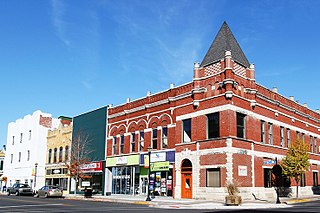
Kokomo is a city in Indiana and the county seat of Howard County, Indiana, United States. It is the principal city of the Kokomo, Indiana Metropolitan Statistical Area, which includes all of Howard County, the Kokomo-Peru CSA, which includes Howard and Miami counties, as well as the North Central Indiana region consisting of six counties anchored by the city of Kokomo. Kokomo's population increased from 45,468 at the 2010 census to 59,604 in the 2020 census.

The Brass Era is an American term for the early period of automotive manufacturing, named for the prominent brass fittings used during this time for such things as lights and radiators. It is generally considered to encompass 1896 through 1915, a time when these vehicles were often referred to as horseless carriages.

Front-wheel drive (FWD) is a form of engine and transmission layout used in motor vehicles, where the engine drives the front wheels only. Most modern front-wheel-drive vehicles feature a transverse engine, rather than the conventional longitudinal engine arrangement generally found in rear-wheel-drive and four-wheel drive vehicles.
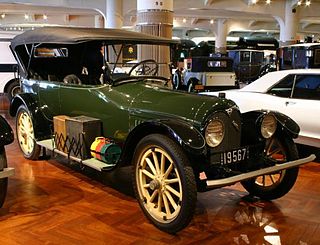
The Apperson was a brand of American automobile manufactured from 1901 to 1926 in Kokomo, Indiana.

De Dion-Bouton was a French automobile manufacturer and railcar manufacturer operating from 1883 to 1953. The company was founded by the Marquis Jules-Albert de Dion, Georges Bouton, and Bouton's brother-in-law Charles Trépardoux.
AZLK Soviet and Russian automobile manufacturer (Moscow), the maker of the Moskvitch brand.

Charles Edgar Duryea was an American engineer. He was the engineer of the first-ever working American gasoline-powered car and co-founder of Duryea Motor Wagon Company. He was born near Canton, Illinois, a son of George Washington Duryea and Louisa Melvina Turner, and died in Philadelphia, Pennsylvania, but spent most of his life working in Springfield, Massachusetts. It was in Springfield that Charles and his brother, Frank, produced and road-tested America’s first gasoline-powered car.

Elmore Manufacturing Company was a manufacturer of veteran and brass era automobiles and bicycles (1893–97), headquartered at 504 Amanda Street, Clyde, Ohio, from 1893 until 1912. The company took its name from a small parcel of land in Clyde with the name Elmore associated with it where a stave mill was established originally, then evolved into bicycle production. The village of Elmore, Ohio is located 20 mi (32.2 km) to the east. Founded by Harmon Von Vechten Becker and his two sons, James and Burton, the Elmore used a two-stroke engine design, in straight twin or single-cylinder versions. They later produced a straight-3 followed by a straight-4 beginning in 1906 until production ended in 1912. The company advertising slogan was "The Car That Has No Valves", referring to the two-stroke engine.

The Knox Automobile Company was a manufacturer of automobiles in Springfield, Massachusetts, United States, between 1900 and 1914. Knox also built trucks and farm tractors until 1924.
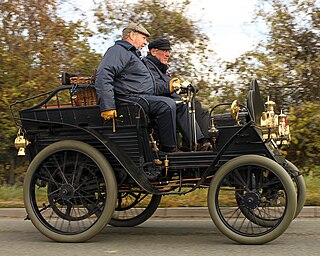
The Mors automobile factory was an early French car manufacturer. It was one of the first to take part in automobile racing, beginning in 1897, due to the belief of the company founder, Émile Mors, in racing's technical and promotional benefits. By the turn of the century, automobile racing had become largely a contest between Mors and Panhard et Levassor.
The National Motor Vehicle Company was an American manufacturer of automobiles in Indianapolis, Indiana, between 1900 and 1924. One of its presidents, Arthur C. Newby, was also one of the investors who created the Indianapolis Motor Speedway.

The Pope-Toledo was one of the makes of the Pope Motor Car Company founded by Colonel AA Pope, and was a manufacturer of Brass Era automobiles in Toledo, Ohio between 1903 and 1909. The Pope-Toledo was the most expensive of the Pope range and was the successor to the Toledo of the International Motor Car Company. In 1909 the company was taken over by Richard D. Apperson of the American National Bank of Lynchburg, Virginia.

The Haynes Automobile Company was an American automobile manufacturing company that produced automobiles in Kokomo, Indiana, from 1905 to 1924. The company was formerly known as the Haynes-Apperson company, and produced automobiles under that name from 1896 to 1905. Co-founder Elwood Haynes changed the name of the company after fellow co-founders Elmer and Edgar Apperson left to form the Apperson Brothers Automobile Company in 1901. The company was declared bankrupt in 1924 and went out of business in 1925.
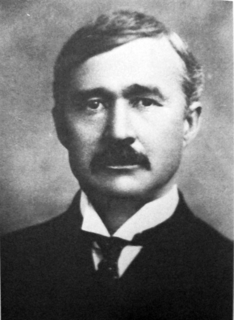
Elwood Haynes was an American inventor, metallurgist, automotive pioneer, entrepreneur and industrialist. He invented the metal alloy stellite and independently co-discovered martensitic stainless steel along with Englishman Harry Brearley in 1912 and designed one of the earliest automobiles made in the United States. He is recognized for having created the earliest American design that was feasible for mass production and, with the Apperson brothers, he formed the first company in the United States to produce automobiles profitably. He made many advances in the automotive industry.

The Lambert automobile and Lambert truck were vehicles built from 1905 through 1916 by the Lambert Automobile Company in Anderson, Indiana, United States. The Lambert automobile was an outgrowth from the Union automobile made by the Union Automobile Company, a previous vehicle that was being manufactured by John William Lambert. The factory manufactured about 3,000 automobiles and trucks per year by 1915 and had several models ranging in price from $1,200 to $3,000 at the time. The vehicles came with a gearless friction drive transmission. The demise of the manufacture of automobiles and trucks came about because of World War I.

The Lambert Automobile Company developed as a 300,000-square-foot (28,000 m2) automobile factory in Anderson, Indiana. It manufactured the Lambert automobile, truck, fire engine and farm tractor as a part of the governing Buckeye Manufacturing Company. Lambert manufactured vehicles from 1905 to 1915. In 1910 the company had over a thousand employees, and from 1910 to 1915 the production had reached about three thousand vehicles per year. It went out of business in 1917 because of World War I.
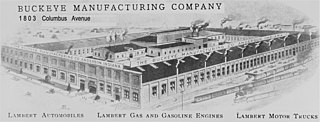
The Buckeye Manufacturing Company was a company founded in 1884 by John William Lambert and his family members originally to manufacture horse drawn buggy parts in Union City, Ohio. The enterprise started with $2,000 and six men and some helper boys. The company got involved in making tools and one early horseless carriage automobile.

The Union Automobile Company was an automobile factory to manufacture the Union automobile through the Buckeye Manufacturing Company. It began manufacturing automobiles in 1902 and produced them through 1905. The company was located in Union City, Indiana. The inventor of Union automobile gasoline engine and friction drive gearless transmission was John W. Lambert. In the early part of 1905 the company moved to Anderson, Indiana. It had produced 325 automobiles before going out of business in the later part of 1905. It was replaced with a redesigned model that became the Lambert automobile.

The Elwood Haynes Museum is a museum in the former mansion owned by Elwood Haynes located in Kokomo, Indiana. Haynes was an inventor who is credited with being the first to produce cars commercially in 1894. He also invented stainless steel and stellite. He became a millionaire in 1916 and had the mansion located on south Webster Street built, where he lived until his death in 1925.

Edgar Apperson was an American automobile manufacturer and engineer.























